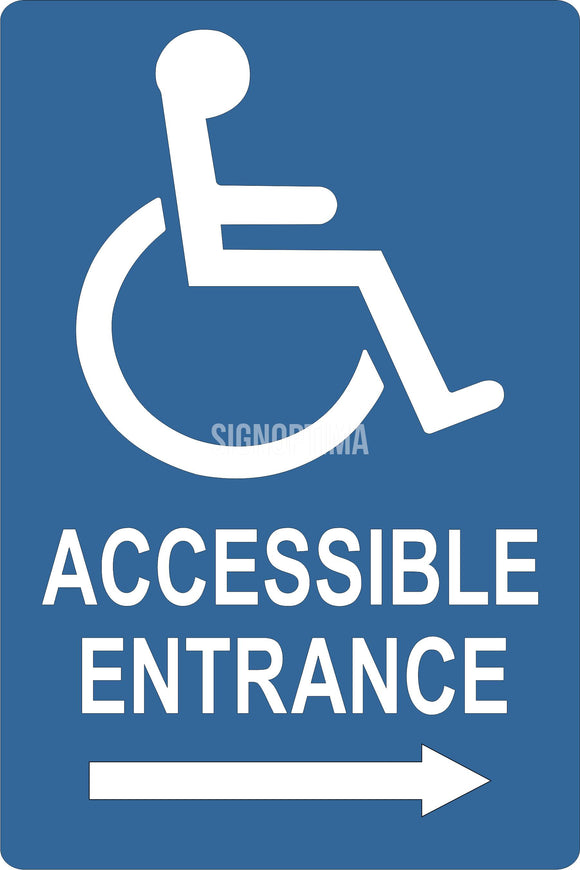A Comprehensive Guide to Picking the Right ADA Signs
A Comprehensive Guide to Picking the Right ADA Signs
Blog Article
Checking Out the Trick Attributes of ADA Signs for Enhanced Ease Of Access
In the realm of accessibility, ADA indicators offer as quiet yet powerful allies, ensuring that areas are navigable and inclusive for people with disabilities. By incorporating Braille and responsive elements, these indicators break obstacles for the aesthetically impaired, while high-contrast color systems and clear typefaces cater to varied visual requirements. Their calculated placement is not approximate however rather a calculated initiative to assist in seamless navigating. Yet, past these features exists a deeper story regarding the development of inclusivity and the ongoing dedication to creating fair areas. What a lot more could these signs indicate in our quest of global availability?
Significance of ADA Conformity
Ensuring compliance with the Americans with Disabilities Act (ADA) is essential for promoting inclusivity and equivalent access in public areas and offices. The ADA, enacted in 1990, mandates that all public facilities, companies, and transport solutions accommodate individuals with specials needs, guaranteeing they enjoy the exact same legal rights and possibilities as others. Conformity with ADA standards not only satisfies lawful commitments yet also enhances an organization's track record by showing its dedication to variety and inclusivity.
Among the key aspects of ADA compliance is the application of easily accessible signs. ADA indicators are designed to ensure that individuals with impairments can quickly navigate with areas and structures. These indications need to abide by certain standards relating to size, font style, color contrast, and placement to guarantee visibility and readability for all. Properly implemented ADA signs aids remove obstacles that individuals with specials needs commonly come across, consequently promoting their independence and self-confidence (ADA Signs).
Furthermore, adhering to ADA guidelines can mitigate the threat of lawful consequences and potential penalties. Organizations that fall short to abide by ADA guidelines might face penalties or claims, which can be both financially challenging and harmful to their public picture. Thus, ADA conformity is integral to promoting an equitable atmosphere for everyone.
Braille and Tactile Aspects
The consolidation of Braille and tactile components right into ADA signage symbolizes the concepts of availability and inclusivity. It is typically put underneath the equivalent message on signage to guarantee that individuals can access the information without visual support.
Responsive aspects prolong beyond Braille and include raised symbols and personalities. These parts are made to be noticeable by touch, enabling individuals to identify room numbers, washrooms, exits, and other critical locations. The ADA establishes details standards relating to the size, spacing, and positioning of these responsive aspects to optimize readability and ensure uniformity throughout different environments.

High-Contrast Shade Schemes
High-contrast color pattern play a pivotal duty in improving the visibility and readability of ADA signage for people with visual problems. These plans are vital as they make best use of the difference in light reflectance in between text and history, making certain that indications are conveniently noticeable, even from a range. The Americans with Disabilities Act (ADA) mandates the use of details shade contrasts to accommodate those with minimal vision, making it a critical element of conformity.
The effectiveness of high-contrast shades hinges on their ability to attract attention in different lights conditions, consisting of dimly lit atmospheres and areas with glow. Generally, dark message on a light background or light message on a dark background is used to achieve ideal comparison. As an example, black message on a white or yellow history offers a raw aesthetic distinction that assists in fast recognition and understanding.
Legible Fonts and Text Dimension
When considering the design of ADA signage, the choice of legible fonts and ideal message dimension can not be overemphasized. The Americans with Disabilities Act (ADA) mandates that font styles should be sans-serif and not italic, oblique, script, highly attractive, or of uncommon type.
The dimension of the text also plays a pivotal role in accessibility. According to ADA guidelines, the minimal message elevation must be 5/8 inch, and it must enhance proportionally with viewing distance. This is specifically vital in public areas where signage requirements to be read promptly and properly. Consistency in text dimension adds to a natural aesthetic experience, aiding individuals in navigating environments effectively.
In addition, spacing between letters and lines is indispensable to clarity. Adequate spacing stops characters from showing up crowded, enhancing readability. By sticking to these standards, designers can considerably Learn More boost ease of access, making certain that signage offers its intended function for all people, no matter their aesthetic recommended you read capabilities.
Efficient Positioning Techniques
Strategic positioning of ADA signage is necessary for optimizing ease of access and making certain compliance with legal requirements. Properly positioned indicators guide individuals with specials needs effectively, helping with navigating in public rooms. Key considerations consist of distance, exposure, and elevation. ADA guidelines stipulate that indications ought to be installed at an elevation in between 48 to 60 inches from the ground to guarantee they are within the line of view for both standing and seated people. This standard height array is vital for inclusivity, enabling wheelchair users and individuals of differing elevations to access information effortlessly.
Additionally, indicators have to be positioned nearby to the latch side of doors to allow easy recognition prior to entrance. This placement aids people find rooms and spaces without blockage. In situations where there is no door, signs should be positioned on the nearby nearby wall. Uniformity in indication placement throughout a center improves predictability, decreasing complication and enhancing overall customer experience.

Final Thought
ADA indicators play a vital role in promoting availability by incorporating attributes that address the needs of individuals with disabilities. These elements collectively foster an inclusive environment, underscoring the importance of ADA conformity in making certain equivalent accessibility for all.
In the world of availability, ADA indications serve as quiet yet effective allies, making sure that areas are navigable and inclusive for people with impairments. The ADA, enacted in 1990, mandates that all public facilities, companies, and transportation services suit people with impairments, ensuring they delight in the very same civil liberties and opportunities as site others. ADA Signs. ADA indicators are made to make certain that people with impairments can easily browse with areas and structures. ADA standards stipulate that indicators ought to be mounted at an elevation between 48 to 60 inches from the ground to guarantee they are within the line of sight for both standing and seated people.ADA indications play a vital duty in promoting access by incorporating attributes that attend to the needs of individuals with disabilities
Report this page